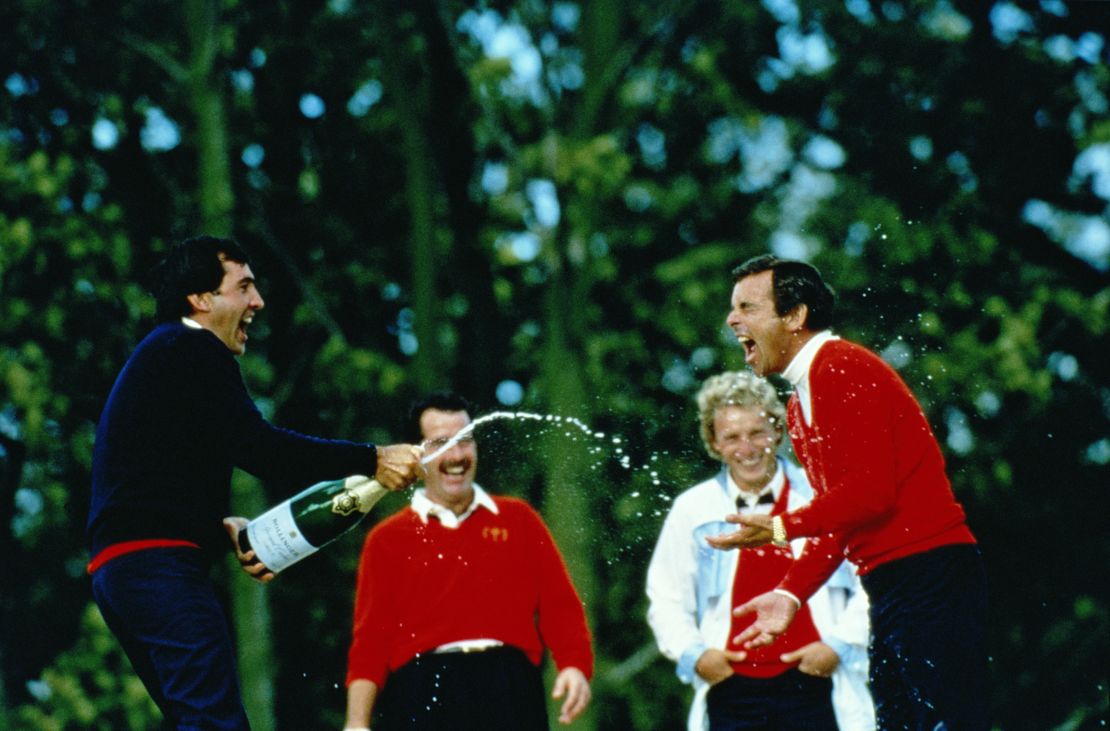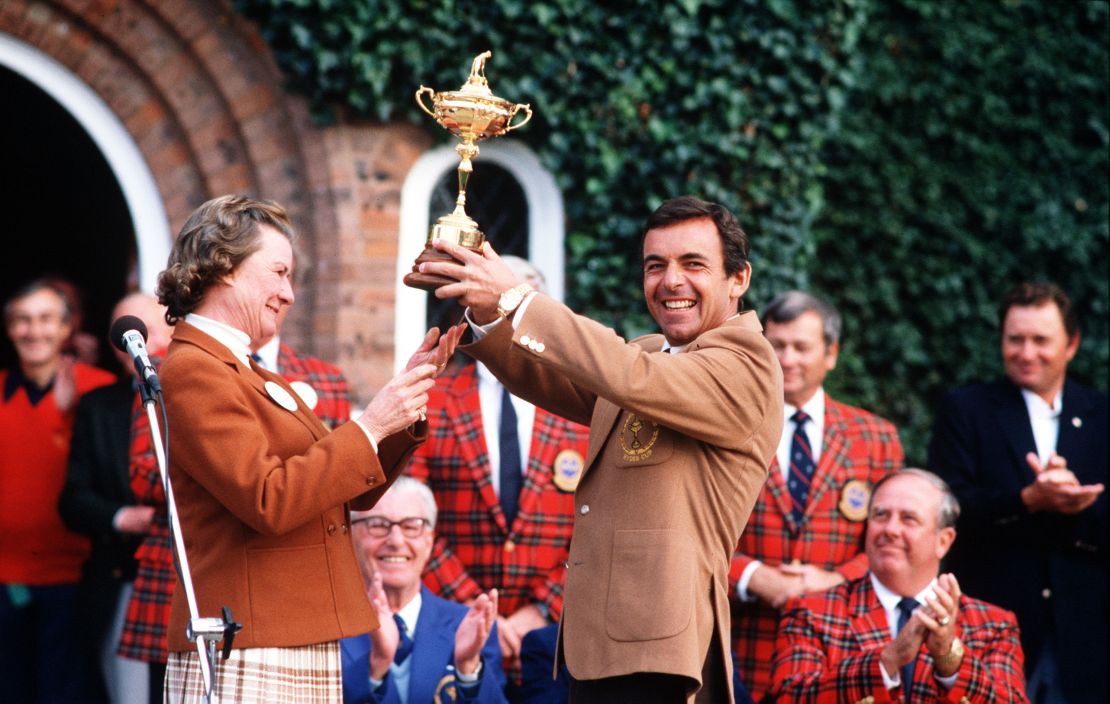Story highlights
Ryder Cup starts on September 30
Team Europe going for fourth straight win
US once dominated the golf event
Tony Jacklin led European success
When the US lifted the Ryder Cup for the 13th time in succession in 1983, few imagined how long the Americans would have to wait before their next success in golf’s most prestigious team competition.
After all, the US was undefeated since 1959, beating Great Britain, Great Britain and Ireland – and eventually Europe, when the event was revamped in 1979.
Nonetheless, the golf world was about to shift on its axis – and that new balance of power remains in place 33 years later.
When Europe’s players walk out at Hazeltine on September 30, they’ll be aiming for a fourth straight victory.
So how did the team go from Ryder Cup whipping boy to an unstoppable force?
Revolution
“We were just not getting it right – we were approaching it totally wrong,” Tony Jacklin, Europe’s most successful Ryder Cup captain, told CNN’s Living Golf show.
When Jacklin was offered the chance to captain the side at the 1983 tournament, he did not accept immediately – things had to change.
“I recognized some issues,” said the two-time major champion. “Our self-esteem was down before we had even hit a ball.
“The Americans had the best of everything – we had anything anybody would give us, flying at the very back of the plane.
“We couldn’t take our caddies. There were issues like that, so I just started a list. It was nothing but leveling the playing field, as I saw it.
“Once they said that everything I wanted was there, then I was making the rules. I said, ‘In that case I’ll do it.’”
Read: Europe captain reveals wildcard picks
Right man
If there was one man who knew the American psyche, it was Jacklin.
He was the only European player to win the US Open between 1926 and 2009, triumphing at Hazeltine a year after his maiden major win at Royal Lytham and St. Annes in 1969.
Playing on the PGA Tour, he was used to going up against the likes of Arnold Palmer, Jack Nicklaus and Lee Trevino. He also saw the different ways the Ryder Cup players were treated by their ruling bodies.
Read: Europe wins 2014 Ryder Cup at Gleneagles
“You’re representing your team and country, and we were being sent out there by administrators who didn’t know what it was like to hit a meaningful five-foot putt,” Jacklin, now 72, says of the European approach.
“When you’re up against an adversary like the Americans then you need all the armory you can get.
“We never had a team room, we used to huddle in the corner of the locker room – ‘You’re going to play with him tomorrow, you’re going to play with him’ – and then you were all free to go away at night with your partner to local restaurants in the town, and none of that was conducive to creating a team spirit.
“My feeling was that we needed to be together all the time – we needed team unity. They needed to know I was part of that. I just wanted to make them feel as comfortable as possible so they could play their best.
“I never told them how to play, it was just mutual respect because they delivered in kind. As soon as they started being treated like first class citizens and professionals they would perform – sometimes beyond the outer limits of their abilities.”
New era
By the time the 1983 tournament came around, Jacklin had begun his revolution.
He was returning to the Ryder Cup after missing out for the first time since making his debut in 1967, but now he would be the non-playing captain.
The team flew to Florida on Concord – it wore a uniform, took its own caddies and looked like a team rather than a collection of guys who had just happened to walk into a major international tournament.
Suddenly Europe’s players began to overcome the inferiority complex that had hampered them in the past.
They may have lost at Palm Beach Gardens, Florida, but the 14½-13½ scoreline was the closest since 1969.
Read: Woods tipped for US top job
“Tony was a fantastic captain,” Sam Torrance, who hit the winning putt for Europe in 1985, told Living Golf.
“He transformed the Ryder Cup for us, he made everything first class – which sounds a bit simple, but it made us feel special.
“We had cashmere clothing, leather golf bags, flying on Concord, beautiful hotels.
“That’s what the Ryder Cup was about. You’re meant to feel very special – you’ve made it, you’ve become part of an iconic team.
“He was the US Open and British Open winner and we didn’t have many of them around in those days – it was very special.”
Having lost by nine points in England two years before – when Jacklin was omitted and Seve Ballesteros dropped due to a pay dispute – few gave Europe a chance of inflicting the Americans’ first defeat since 1957.
But with Ballesteros back in the groove, the visitors went into the final day level at 8-8 and then it was 13-13 with just two matches remaining.

Lanny Wadkins birdied his final hole to secured a half point against Jose-Maria Canizares, while Tom Watson sealed victory against Bernie Gallacher.
“That ended up being so disappointing,” Jacklin recalls.
“We were so close to getting it done. It was by far and away the best performance we had ever had on American soil.
“That was the real beginning, not 1985. That was the beginning because we created a precedent there. Everybody was comfortable, everybody was happy and there was the nucleus of the team which was more or less the same in 1985.
“The confidence that we got from that finish in America helped us carry it off on home soil with the support of the crowd.”
Fightback
By the time the US arrived at The Belfry two years later, Europe was a team transformed.
Ballesteros, Bernhard Langer and Sandy Lyle had won three of the five preceding major titles, and confidence was growing.
“I remember the first meeting we had in the team room in 1983 – it was the first time we had ever got together and really talked,” Jacklin says.
“I said, plain and simple, ‘However big your ego is, we’re all going to leave them outside on the hook – they don’t come into this room.’
Read: Rome to host 2022 Ryder Cup
“We were on a mission to win something very special and we hadn’t done that well in the past.
“I said we had to work together, be strong and get this thing done, and nobody had any issue with anyone else.
“Everybody gave 100% and knew that whatever I was asking for would benefit the whole team.”

Backed by a passionate home crowd, Europe went into Sunday’s singles matches with a lead of two points.
The Spanish pair of Ballesteros and Manuel Pinero had won three out of four points as Europe overcame a first-day deficit to take control.
While Ballesteros was the big name, it was the unsung Pinero – who never played at the Masters or the US Open, and missed the cut at his sole PGA Championship appearance – that set the tone.
Team talk
“Virtually nobody wanted to play Lanny Watkins in the singles,” Torrance recalls. “Why would you want to play the best player in the singles?
“Pinero jumped right out of his seat – ‘I want Watkins,’ he shouted – and we all looked at him and said, ‘You can have him, fella.’
“The US put Watkins out first and Lanny was a megastar at the time – and Pinero beat him.
Read: How Europe stunned US at Medinah in 2012
“Now, imagine what that did to the 11 of us playing behind him? The night before he said he wanted Watkins – he got him, beat him and that was magnificent.”
Pinero’s early victory laid the groundwork for an unforgettable day for Europe which culminated in Torrance holing an 18-foot putt to spark wild scenes of celebration.
Europe won seven of the final day’s singles to secure a 16½-11½ victory.
“They were the best that Europe had and God bless, they performed like it too,” Jacklin says.
“They became stars in their own right, they were all amazing and it was so satisfying.”
Who will win this year’s Ryder Cup? Give us your verdict on our Facebook page
The celebrations lasted long into the night, but the winning didn’t stop there – far from it.
Europe’s first victory on American soil followed two years later at Muirfield Village in one of Jacklin’s finest hours.
Foundations
Jacklin’s groundwork laid the foundations for today’s European domination – since 1995 it has won eight of the 10 tournaments and is unbeaten since 2008.
Seven of the players who took part in the Ryder Cup under his leadership went on to become captains themselves, furthering his legacy.
“They all had the experience of what we created,” Jacklin says of his proteges.
“The most important thing is the commitment shown by the team … the history and the victories, that gives you confidence.
Like this story? Get more at cnn.com/golf
“The Americans are going to win this thing sometime – you can’t win every time – but we’ve had a tremendous run.
“What we’ve achieved over the past 30-odd years is phenomenal.”









